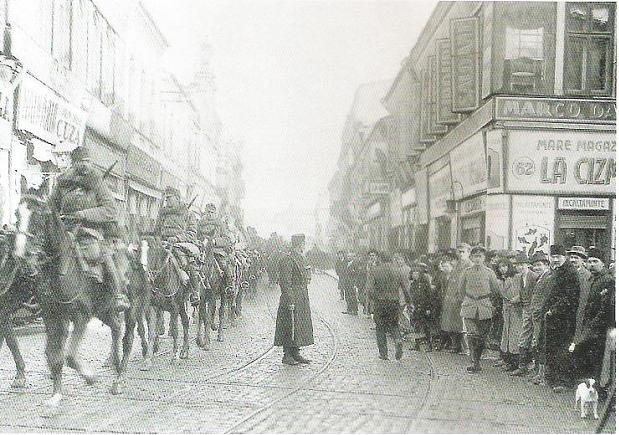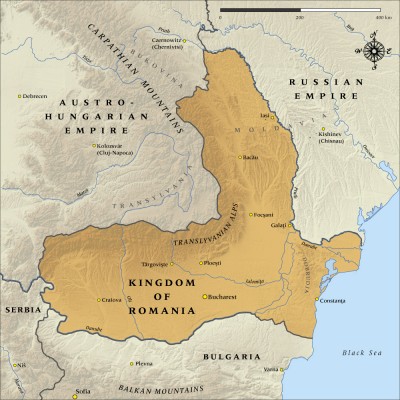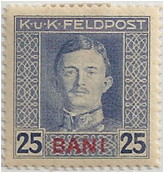ALBUM – View my Austro Hungarian occupation of Romania in ww1 Album
Fast Facts
Region: Central / Eastern Europe
Group: Occupations in World War 1
Classification: Military Occupation
Prior Regime: Kingdom of Romania
Key Dates:
1916, Aug 27 – Romania declares war on Austro Hungary, launching a surprise attack
1916, Dec 3 – Romania defeated by the Central Powers
1818, Mar 7 – Treaty of Bucharest, where Romania surrenders, and makes territorial concessions
1918, Nov 30 – Romania re-enters the war
Following Regime: Kingdom of ROmania
Scott Catalogue: (Romania, Occupation Stamps) 1N1-1N34
Pick Catalogue: (Romania, WW1, German Occupation) M1-M8
History

As World War 1 spread, Romania began negotiating an agreement with the Triple Entente (Britain, France and Russia) for Romania to enter the war on the side of the Allies. In return, Romania would be provided military support from the Russians, provisions in support for the war, and afterwards Romania would be given the territories of Transylvania, Banat and Bukovina, which was currently under Austria-Hungarian rule. Transylvania had long been desired by Romania, as it had a majority ethnic Romanian population. The agreement was signed on 18 Aug, 1916 and on 27 Aug Romania declared war against Austria-Hungary.
Romania launched a major offensive into Transylvania, catching the Austro-Hungarians by surprise. While they experienced some early successes, however in Oct 1916, with combined forces of the Germans, Austrians, Bulgarians and Ottomans, the Central Powers repulsed the Romanian attacks, and within two months had completely overrun the country. On 6 Dec, 1916, Central Powers forces marched into Bucharest, while the Romanian Army, along with the Romanian government was forced to retreat to eastern Moldavia, where it joined up with Russian forces. The Romanians, with support from the Allies and the Russian Army were able to hold the line, rebuilding their army as best as they could.

map from: http://www.nzhistory.net.nz/media/photo/map-kingdom-romania-1916
In the second half of 1918, with major victories by the Allies, the Central Powers collapsed and the war began to wind to a close with complete victory by the Allies. Emboldened by the changes in the war, on 10 Nov, 1918, Romania announced that it unilaterally revoked the Treaty of Bucharest, and re-entered the war on 10 Nov, 1918. This was one day before the armistice between Germany and the Allies was signed to end the war in Western Europe. With the retreating forces of the Central Powers, the Romanian Army moves out of Moldavia into the previously occupied Romania, and continued its advance into Austrian territories of Transylvania, Banat and Bucovina.
The King returned to the capital on November 30th, and ultimately the Treaty of Versailles nullified the Treaty of Bucharest, additionally giving Romania control of the long desired province of Transylvania, as well as additional territories which make up most of Romania today.
This did not totally end the fighting in the region. In 1919, many of the ethnic groups and factions within the territories of the former Austro Hungarian Empire, such as in Temesvár (Timişoara), the capital of the Banat region, took advantage of the uncertainty and turmoil, vying for control of lands formerly under the empire’s control. Ultimately the uprisings were quelled and the final borders were confirmed.
Stamps
 ALBUM
ALBUM
In 1917, during the occupation of Romania by the Central Powers, Germany and Austria-Hungary issued occupation postage stamps. The Austrian stamps used KuK FELDPOST stamps surcharged into Romanian currency (bani and lei). The stamp design, featuring Emperor Karl of Austria was used in many areas during the war, with the bottom intentionally left blank so that local denominations could be printed on the stamp. Seventeen different denominations were issued from 3 bani to 4 lei).
The following year, in 1918, new stamps were issued with the same denominations. Again, using the KuK FELDPOST stamps with an almost identical design, the bottom of the stamp featured an unprinted box for the currency unit to be printed in. It was felt that it would make the stamps more legible.
Banknotes
In 1917, during the occupation, the Central Powers issued 8 occupation banknotes in 25, 50 Bani, 1, 2, 5, 20, 100, 1.000 lei. The Occupation notes were issued from the “Banca Generala Romania”.
Links
Romania during World War 1 – Wikipedia
Romania in 1916 from NZ history online
Romania during WWI by Lubor Kunc





I found this post a three years after posted,but its good to know something about Romania part in this war.I wanna know something about regime under AU,maybe next time 🙂 Sorry about english.
Hy!!!!
I am a PhD student at University of Eastern Finland and I currently working at publishing my first academic article. The article is about history of Romanian football. Through this message I would like to get your acceptance of using your map in my article. I am looking forward to receive an e-mail with your response.
Andrei Antonie
Hei Andrei
I will send you an email as well, but a better graphic of this map is from nzhistory.net. It was created by Geographx with research assistance from Damien Fenton and Caroline Lord. It is licensed under the Creative Commons Attribution-NonCommercial-NoDerivs 3.0 New Zealand License, and can be used for non commercial use. The permission information can be found at the above link. Realizing I missed providing appropriate reference, I have corrected the situation.
I wish you success on your article.
Michael
I can imagine there is still some heated opinions about who deserves what in that region.
The big loser was Hungary, which lost 70% of its land base after WW I.
http://bigblue1840-1940.blogspot.com/2012/11/ClassicalStampsHungary19161940.html
Jim
Very nice write up on Hungary. I have linked to it on my Temesvár page, and will do so when I get around to covering this period. I dread going through my stamps of the post WW1 Hungary timeframe as there are sooo many forgeries in these stamps.
Michael
A correction is due: Hungary occupied parts of other countriesd that were not Hungarian, therefore regarding Hungary as a whole state is a misconcept. Example: it occupied parts of nowadays Roumania only in 1869, for 51 years. Until then, Transylvania, for instance had been a separate Principality (one of the major Roumanian provinces ant the heartland of the ancient kingdom Dacia – and a full Roman Province for some time. In 1699-1718 (Peaces of Passarowitz and Karlowitz) Transylvania was occupied by AUstria, along with other territories of the area (inter alia, nowadays Hungary was also occupied then)
Also, Hungary occupied Croatia and Slovakia when the Habsburg empire separated in 1869 into two parts. Or, rather, it RECEIVED these non-Hungarian lands for administration. Suggesting that Hungary lost 70% of its territory is highly inaccurate. all those lands simply returned to their independent status.
Lest should be forgotten, Hungary actually did not exist from 1526 to 1869 as a country. Until ca. 1718 when it was occupied by Austria, Hungary was an Ottoman military-ruled province (a Pachalyk).
The so called Hungary of 1869 was ca 70% non-Hungarian territory, actually.
…and afterwards Romania would be given BACK! the territories of Transylvania, Banat and Bukovina..” for avoiding any Misunderstanding , there should be the word BACK, cos those territories were just occupied and belonged to Romania before.
Hello Lucy
Thank you for your comment. As I understand Romanian history, Romania declared independence from the Ottoman Empire in 1878, where the Kingdom of Romania was recognized for the first time as an independent “unified” nation. The kingdom consisted of a united Moldavia and Wallachia. Transylvania and the others remained under Hapsburg rule (taken from the Ottomans in 1687) as parts of the Austro-Hungarian Empire. I do understand that these areas had a very large Romanian population, but other than a very brief period from 1600-1601 when Michael the Brave created a personal union of the three principalities, I don’t find where Transylvania was part of a greater independent Romanian country until 1919.
If I am in error (which wouldn’t be the first time), I am happy to acknowledge this in the article. If you believe that I am, all I ask is that you please point me to a reference of a united Romania.
By the way, I have visited Romania, and found that Transylvania, Moldavia, Bucovina and Maramureş were particularly lovely places. Thank you again for your comment.
Michael
The history of Hungary is simple:
(Actually, Hungary was GIVEN Transylvania by Austria in 1869.)
Hungary as territory:
– inhabited by Dacs (Romanian ancestors) – known: ca 6000 BC.
– part of the Dacic Kingdom of Dromichaites and then Burebista (stretching as far as into nowadays Germany and Ukraine)
– Roman province of Pannonia.
– temporarily colonised by Huns, 3-rd century (practially destroyed at the battle of the Catalaunic plains, in Gaul)
– colonised by Slavs ca 4-th/5-th century AD
– colonised by Gauls (the family name Gal is one of the most common in Hungary even today)
– Hungarians settled in Pannonia in 896 (wars with the populations in the neighbouring lands). An Asiatic population related mostly to Turks and some Mongols.
– 1000 AD – Christenised by Stephan by crossing a river. ALL OF THEM (how many could have they been actually?)
– 12-th century – the Arpadian dinasty dies out. (since then, no king of Hungary was ever of Hungarian ethnicity, most were slavs or Roumanians; for instance, their greatest King Mathias was Roumanian, named Matei, the name of the Biblic author – aka Mathew, descendant of Iancu, son of Voicu – Hungarised Janos and irrespectively Vajk, and a petty Roumanian noblewoman of the Hunedoara county.)
– 14-th century – French kings (for instance, Charles Robert d’Anjou attempts to conquer a Roumanian province – defeated and killed)
– 1526 – Hungary defeated, occupied by Ottomans, transformed into a Pacha-ruled district of the Ottoman empire (in other words, it had the same status within the Ottoman empire that Ireland had withing British empire before 1941 or Transylvania, occupied by Hungary in 1869, that is, a distinct territory under foreign occupation, but disappeared as a distinct country)
– 1718 – occupied by Austria, a Province of the Crown, like Bohemia, Bukowina – a few years later -, Lodomeria etc.
1869 – Ausgleich, the dual monarchy appears. Hungarians will RECEIVE to administer non-Hungarian lands: Croatia, Slovakia, some Slovenia, Banat (Roumanian and Serbian) that was also called Southern Hungary, Transylvania (one of the nine major Roumanian provinces) plus a conjoint administration of Bosnia-Herzegovina.
– 1918 – Hungary defeated in WW 1 along with Austria.
– 1919- Bolchevik Hungary of Bela Kuhn (aka Kun). Defeated by Roumania (July-August 1919), occupied until April 1920. Horthy comes to power.
– 1920 Trianon. For the first time in its history, the Hungarians are a majority in their own country and ceased ruling over other nations.
In the mean time, the Hungarians as a race had disappeared very long ago, probably since the 13-th century? You will never see a Hungarian with asiatic traits. Genetically, they stopped being Hungarians a very long time ago, they are mostly Gauls, Slavs – Serbs, Slovaks, some Poles, some Czechs and Ukrainians, some Croats – and Roumanian descendants.
All these data can be checked.
De la Nistru pin la Tisa
Tot Rominul plinsumisa
Ca nu mai poate strabate
De atita strainatate
These well known verses of ??? were censored by ??? to not mention that Basarabia was part of Romania
Nice History lesson.
I was aware that Translyvania was acquired by Romania after WW I, but not the specific circumstances.
They have the Treaty of Versailles to thank. 😉
Thanks Jim
I find it amazing how much I learn when I put these short histories together. The Treaty of Versailles changed the entire landscape of Europe (and the world), and probably begin setting things into motion for the second world war a little more than 20 years later.
Michael
Actually, they have reality to thank. HUngary was GIVEN Transylvania by Austria in 1869.
Hungary
– colonised by Dacs (Romanian ancestors) – ca 3000 BC to 896
– Roman province of Pannonia.
– colonised by Slavs ca 4-th century AD
– colonised by Huns (practially destroyed at the battle of the Catalaunic plains, in Gaul)
– colonised by Gauls (the family name Gal is one of the most common in Hungary even today)
– Hungarians settled in 896
– 1000 AD – Christenised by Stephan
– 12-th century – the Arpadian dinasty dies out. (since then, no king of Hungary was ever of Hungarian ethnicity, most were slavs or Roumanians)
– 1526 – Hungary defeated, occupied by Ottomans, transformed into a Pacha-ruled district of the Ottoman empire (in other words, it had the same status within the Ottoman empire that Ireland had withing British empire before 1941 or Transylvania, occupied by Hungary in 1869, that is, a distinct territory under foreign occupation, but disappeared as a distinct country)
– 1718 – occupied by Austria, a Province.
1869 – Ausgleich, the dual monarchy appears. Hungarians will administer non-Hungarian lands: Croatia, Slovakia, some Slovenia, Banat (Roumanian and Serbian) that was also called Southern Hungary, Transylvania (one of the nine major Roumanian provinces) plus a conjoint administration of Bosnia-Herzegovina.
– 1918 – Hungary defeated.
– 1919- Bolchevik Hungary of Bela Kuhn (aka Kun). Defeated by Roumania.
– 1920 Trianon. For the first time in its history, the Hungarians are a majority in their own country and stooped ruling over other nations.